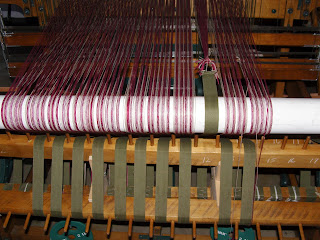How satisfying to see a nice roll of rugs on the cloth beam. They will have to wait until tomorrow evening to be removed, since I still have a bit of warp left that I will make into a sample.
Along the way, while weaving this first warp, I learned some things about the loom. This was my first experience with sectional warping, and it is obvious that Bob and I have to be a little more careful with counting rotations, as evidenced by the photo. Oops! That little bit left to weave will be my sample, and then I am going to undo the edge sections and finish up the warp with a couple placemats on the narrower warp.
Also seen in the bottom edge of the photo are weights that I used on my last four edge threads on each side. I'm hoping with the weighted selvedges, that I won't have wavy edges.
The canisters took a little getting used to to load them. I didn't get a "pink pony" with the loom so I had to do it by hand. I found a pretty thick dowel in the workshop to compress the weft material into the tubes, but it seemed to stick to the insides of the tube, so I tore the cover off an old phone book, and that slippery, heavy paper made it much easier to get the tube loaded. As I filled it a bit, I pulled the paper out more, so I always had a deep tube. My tubes are still rusty, but not so bad on the inside, so no, my fabric did not pick up rust.
The yarn poking out of a couple of the tubes makes good hems on the rugs. It is about the weight of the Sugar and Cream type yarn used to knit dishcloths. I use two strands and get a hem like the white and rust sections with the closer chicken tracks. I do have an industrial sewing machine to sew the thick hems. I could do it on my regular sewing machine with some special techniques, because the yarn is soft, but I don't need to, since the heavy machine is designed for that type sewing. Chicken Tracks even makes a nice hem!
This machine travels! The 2x4s on the floor were braced against the front corners, but they only help a little bit, and then I have to tug at the loom and move it back. I actually think I need to brace it in two directions, since it tends to move forward and to the left. I will have to work on that when I find a more permanent location for the loom. Right now it is in the garage where my car will be this winter.
The tension adjustment on the brake band will determine how far forward the beater will come when beating the rug. Much further back from the front post than this amount will start causing problems with the shed changing mechanism and the fly shuttle mechanism.
I have found that this distance is about ideal, but not any closer.
Broken warp threads seemed to be inevitable, so I quickly learned to leave plenty of extra warp on the repair section. That way, I had enough to pull forward through the heddle and reed and could get the knots between rugs once I finished the rug I was on. Leave enough warp behind the loom to finish the current rug, and enough to weave the next rug. It will save headaches of having knots that you have to keep an eye on behind the heddles.
I like weaving rugs while standing. I think it is easier on my shoulders, and the leverage is great. I never missed the treadles even once!
I thought I learned to keep an eye on the nuts and bolts, to make sure they stayed tight, and then I looked down at the floor, and the nut and washer under the tension rod was on the floor. Before the next warp, I will have to go over the whole loom and tighten everything and oil all the moving metal parts.
Another bolt that I had to keep an eye on was the big bolt holding on the cams. With the loom warped, it isn't visible, so it's an easy one to forget about. It has to be pretty tight, or it will constantly come loose.
All in all, I think I had a pretty successful first warp. I'm anxious to start learning more with my next one.












GREAT FINALE ! ! ! ! ! ! ! Our CAM-BOLT has a NOTCHED-NUT for using a COTTER-PIN TO-KEEP-IT-ON. So check if the nut may have been changed after losing, as well as the verticle hole in shaft for the C-PIN & that should keep THAT-ONE-ON ! ! ! ! ! ! !Now that we are out of TRIPLE-DIGIT-DAYS ,we will see if we can put all the W/D-FLY'N-STUFF in a pile for a pic to get-off to y'all & then THINK-ON how it might be paced for shipment, or carried home in your car.
ReplyDelete